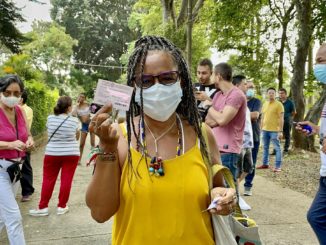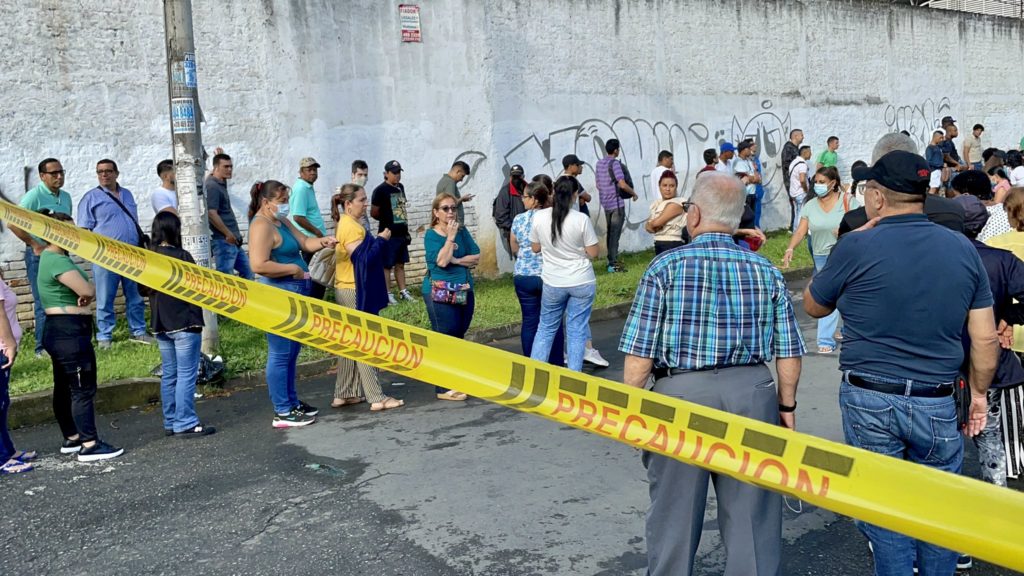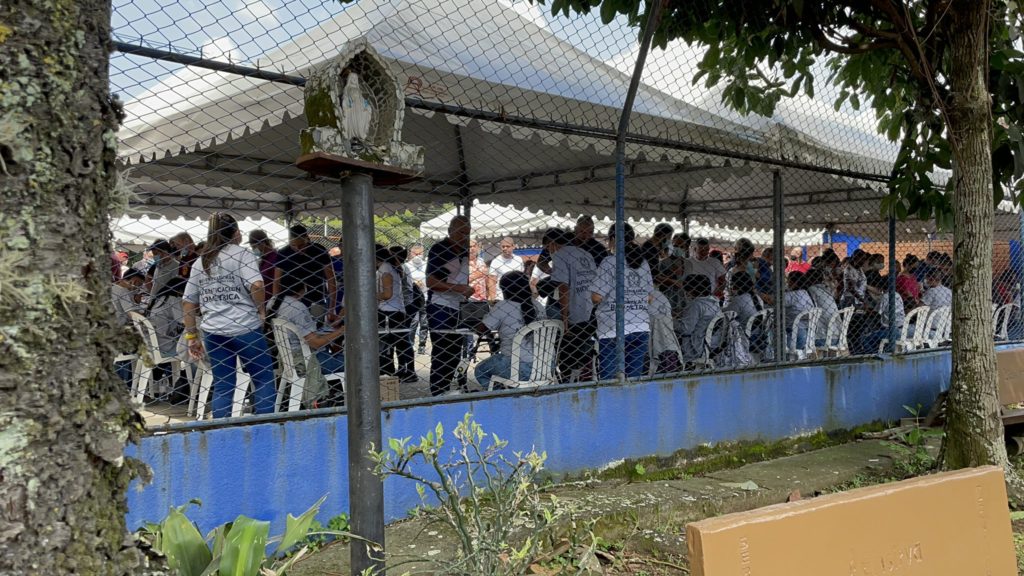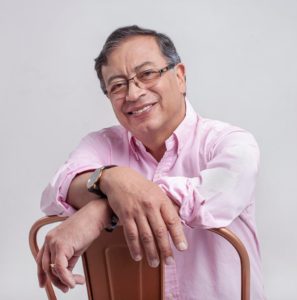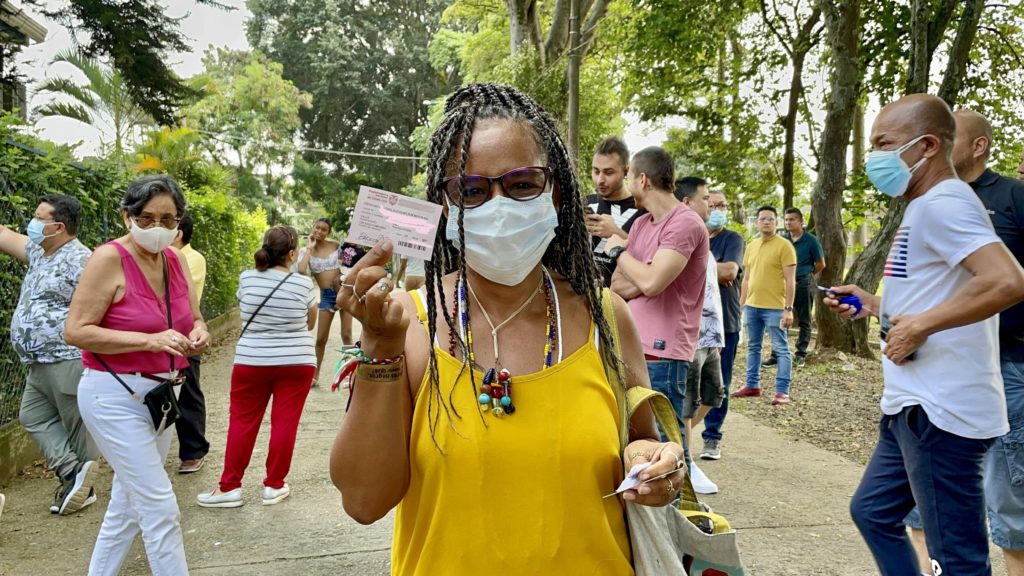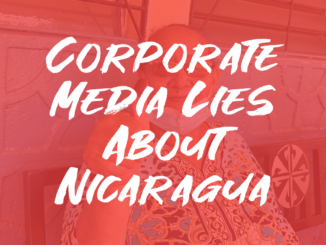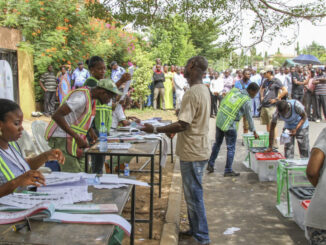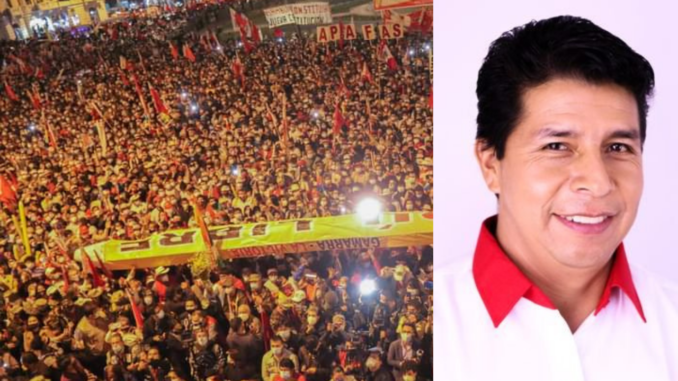
Rising out of the shadows of the Andean highlands, schoolteacher and trade unionist Pedro Castillo appears on the verge of winning the presidency and catapulting Perú toward a future free of neoliberal austerity and U.S. meddling after rallying the oppressed masses of the South American country to support his candidacy.
Castillo leaped into the spotlight of Peruvian national politics when the candidate topped all other competitors in the first round of elections held April 11. Castillo’s party, Free Perú (Perú Libre), also won 18.92 percent of congressional seats, more than other competing parties. Then Peruvians in the country and in the diaspora throughout the world cast their ballots June 6 to determine who would be the country’s leader for the next five years. The election became one of the most contentious in Peruvian history, featuring two candidates who personify polar opposite interests and visions for Perú’s future. Castillo is leading this week with a margin of less than 1 percent after 99.8 percent of votes have been counted.

A trade unionist and native of the Cajamarca region, Pedro Castillo held a lead over Keiko Fujimori, the right-wing daughter of a former despot and currently incarcerated ex-president, Alberto Fujimori. If Keiko Fujimori loses this race, it would be her third time missing the mark in a presidential election.
Fujimori, head of the right-wing Popular Force party, had seen success in Peru’s northern coastal provinces and from foreign votes. But Castillo received a majority of his votes from provinces in the Andean countryside, the Amazon and the southern coast, regions historically neglected and suffering from acute economic exploitation.
When official results first began rolling out to the public, Fujimori held a slight lead over Castillo. But near the end of counting, Castillo surpassed with enough votes to win him the presidency. Fujimori and her attorneys are now asking for a recount on 100,000 Castillo votes, claiming fraud and refusing to recognize Castillo’s victory.
Who is Pedro Castillo?
Nestled in the Andean mountains on the shores of Lake Titicaca lies the town of Puno, where Pedro Castillo was born in 1969. His parents were illiterate peasants, both of whom spent much of their lives working on plantations.
In his youth, Castillo joined the ronda campesinos, or ronderos, a local peasant-based police force launched in place of official Peruvian police, who often were absent and—when they were around—harmed peasant communities. While the ronderos generally exhibited left-wing tendencies, in the Chota district, ronderos found themselves combatting Shining Path insurgents, who were trying to seize control of towns. The Shining Path was a Maoist guerilla insurgency formed out of a split from the Peruvian Communist Party. The organization took up arms against the Peruvian state and against other communist and progressive groups. While the Shining Path committed atrocities, such as the massacre at Lucanamarca, the Peruvian military committed unprecedented human-rights violations in the name of counterinsurgency, leaving peasants in precarious conditions.
Castillo later went on to study at Cesar Vallejo University, named after the Peruvian communist poet. He received a bachelor’s degree in education and a master’s degree in psychology, eventually becoming an elementary school teacher. In 2017, he garnered esteem in Peruvian politics by leading a teacher’s strike against the underfunding of public education as well as teacher’s salaries.
Despite actively defending the Chota district from the Shining Path’s incursions, major Peruvian media conglomerates El Comercio and La República led a media campaign against Castillo, red-baiting the candidate as a “Shining Path terrorist” because of his links with the Movement for Amnesty and Fundamental Rights (Movadef).
Castillo’s party, Free Perú (Perú Libre), identifies as Marxist-Leninist-Mariáteguist, upholding socialism and the power of the working class. While Castillo himself does not openly label himself a communist, he has said he plans to create a new constitution with stronger market regulations, break up monopolies, initiate a second agrarian reform, and revise contracts with multinational companies for stronger labor rights and a greater share of profits for the Peruvian state.
Who is Keiko Fujimori?
At just 19 years old, Keiko Fujimori became the First Lady of Perú—the youngest in Peruvian history—as her father and ex-President Alberto Fujimori stripped his wife Susana Higuchi of her title and threw her into prison when she accused her husband of crimes against humanity.
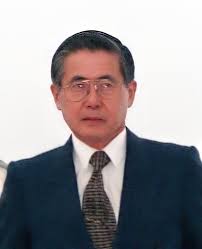
Fujimori is currently facing another trial under charges of forced sterilizations that occurred through his Family Planning Program. This program reportedly sought to target Indigenous women in Perú’s countryside. Despite all this, his daughter, Keiko, has promised that, if elected, she will pardon her father.
Yet, Keiko Fujimori’s legacy isn’t stained only by the crimes of her father. In 2011, Fujimori admitted to having received donations from known narco traffickers. Fujimori also was implicated in the Panama Papers, which exposed illegal donations to her 2011 and 2016 presidential campaigns. Later, in 2018, she was arrested on charges of embezzlement that occurred during her unsuccessful 2011 bid for the presidency.
She left prison in April 2020 on a conditional release due to COVID-19. If Fujimori fails to win the presidency, she faces a 31-year sentence for money laundering.
All the while, notable Peruvian political elites, and even members of the Peruvian national soccer team, threw their support behind Fujimori under the cry to “save Perú from communism.” The Peruvian elite and upper classes have been taking to the streets and to social media, alleging electoral fraud. TV personality and model Alejandra Baigorria went so far as to call for military interference against a Free Perú victory.
Fujimoristas en reunión de blancos…
El comunismo no va a caer, blankito.
El comunismo TE VA a caer.
— El Plebeyo (@unplebeyomas) June 8, 2021
PERÚ LIBRE: ¡Hasta más allá de la Victoria! pic.twitter.com/opFioCe9gO
— Perú Libre (@PERU_LIBRE1) June 9, 2021
📌 [Comunicado]
Frente a la difusión en redes sociales con llamados a la intervención de las Fuerzas Armadas en asuntos netamente electorales o políticos. pic.twitter.com/xEvGmDc139
— Mindef Perú (@MindefPeru) June 9, 2021
The Peruvian Ministry of Defense released a statement Wednesday afternoon stating it will not intervene, citing the constitution and claiming it must maintain a neutral role so it can respect the sovereignty of the Peruvian people.
Since the start of the pandemic, Peru has seen mass unemployment, the highest COVID-19 death rates per capita in the world and a significant increase in national poverty. In the first week of November alone, the country had three presidents, and erupted in national strikes and protests that led to the police-sanctioned murders of Inti Sotelo and Bryan Pintado. Not only that, but in the past 30 years, the country has experienced political instability and brutal repression at the hands of the state.
The Future of U.S.-Perú Relations
Castillo’s victory also would upend U.S. interests in South America. For example, it could help kickstart the process of re-building a coalition of Latin American left-ruled states. Castillo has promised to withdraw Perú from the Lima Group, an organization of countries dedicated to subverting the democratically elected Bolivarian government of Venezuela.
Besides that, the Perú Libre party calls for booting U.S. military bases and the U.S. Agency for International Development (USAID), notorious for using humanitarian aid to undermine democratic processes in other countries, including during the Fujimori dictatorship. While Castillo has publicly opposed the Organization of American States (OAS), he has said he wants to fortify two regional groups: The Community of Latin American and Caribbean States (CELAC) and the Union of South American Nations (UNASUR).
Over the next few years, Brazil, Chile and Colombia will hold presidential elections. With the turn of events in favor of the left in countries like Bolivia and Perú, the future looks hopeful for people’s movements in South America.
The victory of Castillo and Perú Libre, as well as the adoption of a new constitution, could open a path for the country reminiscent of the progressive military government of General Juan Velasco Alvarado. But these elections also have highlighted the deep divide permeating through Perú, one that remains to be resolved whether a Fujimori administration or a Castillo administration comes to fruition.
Kayla Popuchet, a Peruvian national of Perúvian-Haitian descent, studies and writes about Latin America and eastern Europe. She was a 2019 Pulitzer Center Reporting Fellow.

